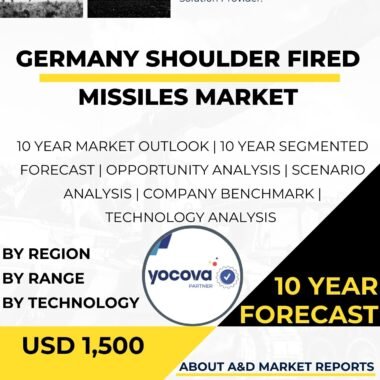Description
The Saudi Arabia Shoulder Fired Missiles Market is a significant and critical segment within the country’s defense industry. Shoulder-fired missiles, also known as man-portable air defense systems (MANPADS), are portable surface-to-air missiles designed to be carried and fired by a single operator. These missiles play a crucial role in enhancing the ground-based air defense capabilities of military forces and providing a deterrent against airborne threats, including enemy aircraft and helicopters.
As a key player in the Middle East region, Saudi Arabia recognizes the strategic importance of acquiring and developing advanced shoulder-fired missile systems to protect its national security interests, defend its airspace, and ensure the safety of its military assets and population.
The Saudi Arabia Shoulder Fired Missiles Market is characterized by a mix of international and domestic companies that specialize in missile development and manufacturing. International defense companies, such as Raytheon, MBDA, and Lockheed Martin, have a significant presence in the market and offer a wide range of shoulder-fired missile solutions.
One of the primary drivers of the Saudi Arabia Shoulder Fired Missiles Market is the country’s focus on enhancing its air defense capabilities. With the ever-present threat of airborne attacks, the Saudi government recognizes the importance of equipping its armed forces with advanced and highly effective shoulder-fired missile systems. These missiles enable ground forces to engage and neutralize enemy aircraft, helicopters, and unmanned aerial vehicles (UAVs), providing a valuable layer of protection to key military installations, critical infrastructure, and forces deployed in the field.
Additionally, shoulder-fired missiles play a critical role in enhancing the effectiveness of Saudi Arabia’s ground forces during combat operations. The mobility and ease of deployment of MANPADS allow infantry units to have an additional anti-aircraft capability, making them more resilient and effective in various tactical scenarios.
The Saudi government’s Vision 2030 economic diversification plan also influences the Shoulder Fired Missiles Market. As part of this vision, Saudi Arabia aims to develop a robust domestic defense industry capable of contributing significantly to the national economy. This includes fostering partnerships and joint ventures with international defense companies for technology transfer and knowledge sharing.
Localization of missile manufacturing aligns with the broader goal of creating high-skilled job opportunities for Saudi citizens and promoting research and development within the country.
These shoulder-fired missiles are designed for engaging low-flying and slow-moving aerial threats at short ranges. They provide a highly mobile and rapid response capability to ground forces.
Medium-range MANPADS offer enhanced engagement capabilities, allowing operators to engage targets at longer distances. These missiles provide greater standoff capabilities and cover larger areas of airspace.
Some shoulder-fired missile systems are designed to be versatile and can engage both aerial and ground targets. These multi-purpose systems add flexibility to ground forces’ capabilities, enabling them to engage a wider range of threats.
The Saudi Arabia Shoulder Fired Missiles Market is witnessing significant technological advancements. The development of advanced seeker technologies, such as infrared imaging and laser guidance systems, has enhanced the accuracy and effectiveness of shoulder-fired missiles. Modern MANPADS are equipped with sophisticated countermeasures against enemy electronic jamming, making them more resilient in challenging electronic warfare environments.
Moreover, shoulder-fired missile systems are increasingly integrated into broader air defense networks, providing seamless coordination and data sharing between ground-based and air defense assets. The integration of MANPADS with radar systems, command and control networks, and other sensor platforms enhances their overall effectiveness and situational awareness.
The Saudi Arabia Shoulder Fired Missiles Market also faces challenges related to ensuring effective training for missile operators and maintaining a robust logistics infrastructure for missile systems. MANPADS operators must undergo extensive training to ensure safe and effective missile engagements, as well as adherence to strict rules of engagement and international norms to prevent misuse or proliferation.
To address these challenges and take advantage of the opportunities, the Saudi government is investing in shoulder-fired missile technology and infrastructure. Providing comprehensive training for missile operators, establishing logistics and maintenance support centers, and collaborating with international defense partners for knowledge exchange are critical elements of this effort.
Moreover, the government is exploring collaborations with international missile manufacturers to exchange best practices and adopt innovative technologies to enhance air defense capabilities.
In conclusion, the Saudi Arabia Shoulder Fired Missiles Market is a vital and evolving segment within the country’s defense industry. As the Saudi government continues to prioritize air defense and invest in advanced shoulder-fired missile systems, the demand for such capabilities is expected to grow.
International defense companies with expertise in missile development and manufacturing will continue to play a significant role in this market. However, the Saudi government’s focus on economic diversification and indigenous defense industry development will drive increased collaboration and technology transfer initiatives.
By fostering local research and development, training programs, and investments in shoulder-fired missile technology and infrastructure, Saudi Arabia aims to build a robust and self-sufficient missile industry, ensuring a high level of air defense capabilities.
As the Kingdom seeks to enhance its air defense capabilities, protect its airspace, and support its ground forces, the Shoulder Fired Missiles Market will remain a critical area of focus within the broader national defense and security efforts.




